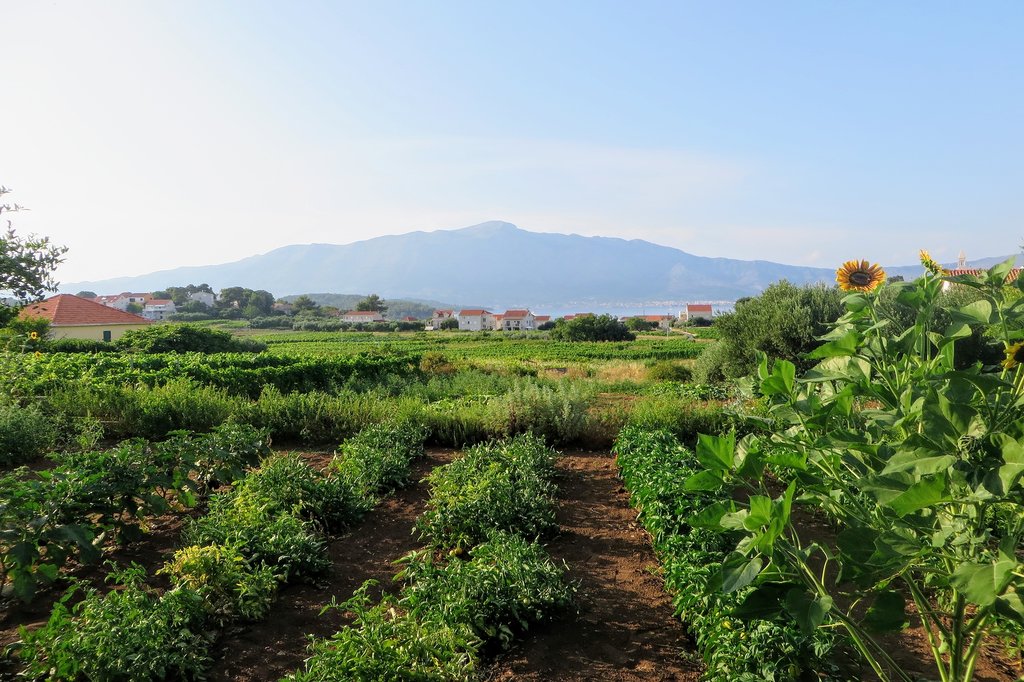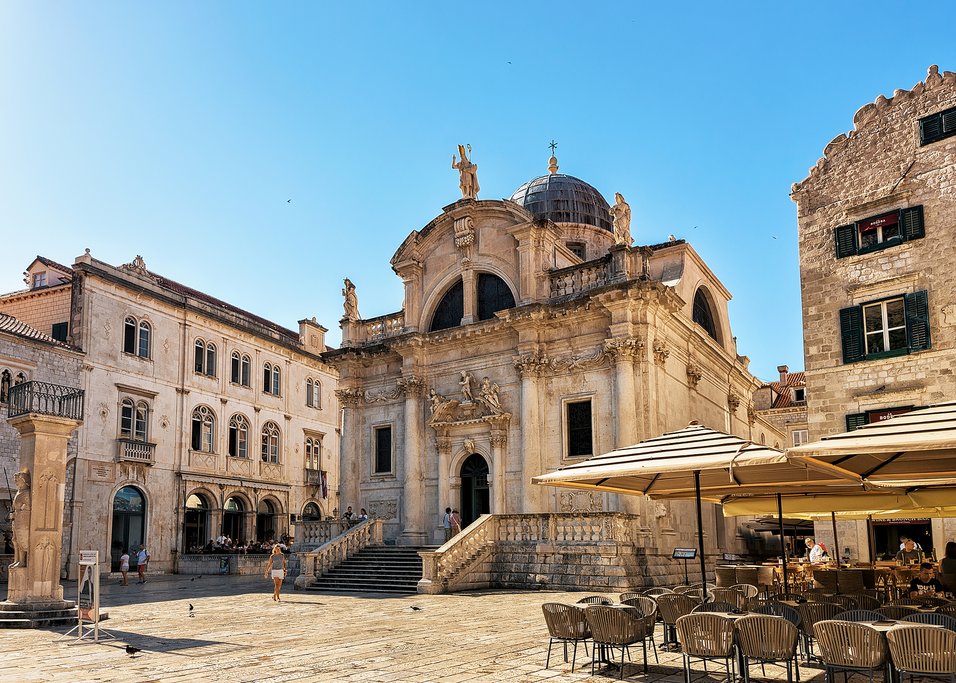Highlights
- Walk Split's 1,700-year-old stone-paved streets, leftover from Roman times
- Admire the impressive Skradinski Buk waterfalls in Krka National Park
- Take in the setting sun while kayaking around the Pakleni Islands
- Explore Ston's stone walls and saltpans
- Wander the 16th-century stone walls of Dubrovnik's Lovrijenac and Revelin fortresses
Brief Itinerary
| Day | Highlights | Overnight |
|---|---|---|
| Day 1 | Welcome to Split! | Split |
| Day 2 | Day Trip to Krka National Park & Šibenik | Split |
| Day 3 | Ferry from Split to Hvar, Sunset Sea Kayaking Tour | Hvar Town |
| Day 4 | Ferry from Hvar to Korčula | Korčula Town |
| Day 5 | Cycling & Wine Tasting Tour in Lumbarda | Korčula Town |
| Day 6 | Korčula to Dubrovnik via Pelješac Peninsula | Dubrovnik |
| Day 7 | Historical Walking Tour of Dubrovnik | Dubrovnik |
| Day 8 | Depart Dubrovnik |
Detailed Itinerary
Day 1: Welcome to Split!

From the airport, it's a short (45-minute) drive to the center of Split. Depending on your arrival time, check into your hotel and take the rest of the day to explore the historic port city on your own.
Founded 1,700 years ago by Roman emperor Diocletian, Split's Old Town consists of a number of impressive sites, including Peristyle, Cathedral of St. Dominus, and Diocletian's Palace, one of the best-preserved Roman buildings in the world. Start in Peristyle Square, taking in the 3,500-year-old sphinxes Diocletian brought back from Egypt before exploring the 4th-century complex. From there, pass through the Iron Gate and into Pjaca Square for pretty views of white marble tiles, a Romanesque clock tower with the remains of a medieval sundial, and the 15th-century Town Hall.
In the evening, take a stroll along Split's seafront Riva to admire the waterfront views before finding the off-beat Konoba Dioklecijan restaurant, just to the left of the Bronze Gate for a bite to eat, its outdoor terrace built into the walls of Diocletian's Palace.
Day 2: Day Trip to Krka National Park & Šibenik

Krka National Park is just over an hour's drive away from Split and is a nice place to visit in the morning before the crowds arrive. You can explore Krka on your own by foot or by rental bike, choosing from a number of trails (the shortest being a mile-long or 2 km boardwalk through waterfalls and small lakes).
Try to visit a couple of sections of the park, including Skradinski Buk, the largest waterfall in the park. After Skradinski Buk, head to Roški Slap, where you can take a short walk across the river to a small set of rapids said to resemble a pearl neckless from above. At Roški Slap, there's a restaurant that serves locally produced prosciutto, cheese, and seasonal salads. Besides waterfalls, the park is also well known for its multiple endemic species of birds, fish, and amphibians.
After spending the morning in Krka, head to the coastal town of Šibenik for the afternoon. A true Croatian town founded by the Croat king Petar Krešimir IV in the 11th century, Šibenik's is home to impressive fortresses, music festivals, and medieval gardens. Start with a visit to the famous St. James' Cathedral, a UNESCO protected site for good reason, before selecting a restaurant for your dinner—perhaps Pelegrini, a restaurant and wine bar just above the cathedral. Return to Split in the evening.
Driving time (Krka to Šibenik): 20 minutes
Driving time (Šibenik to Split): 1.5 hours
Day 3: Ferry from Split to Hvar, Sunset Sea Kayaking Tour

This morning you'll catch a ferry from Split to Hvar and check into your hotel. A Croatian island in the Adriatic Sea, Hvar is a popular destination with tourists due to its natural setting, mild climate, and its historic town of the same name. You'll have the late morning to explore Hvar Town. Visit St. Stephen's Cathedral and climb the steps to the terrace outside of the historic Arsenal to enjoy views over the harbor and the surrounding area.
In the afternoon, pack your swimwear and towel and head to Hvar Town's beachfront for your guided sunset kayaking tour to the nearby Pakleni Islands. The islands are the most beautiful part of the Hvar Riviera and are a favorite retreat for locals seeking to escape the summer heat. Altogether, there are 14 wooded and rocky islets, which you will get a chance to explore by kayak with a striking pink sky as a backdrop.
Ferry time: 1.5-2 hours
Chat with a local specialist who can help organize your trip.
Day 4: Ferry from Hvar to Korčula

Collect your things and catch a ferry to Korčula. Once on Korčula, the afternoon and evening are yours to discover this little island's numerous restaurants, taverns, shops, and bars as you roam the maze of gray stone houses, alleys, churches, and squares.
Enjoy a traditional lunch of lamb and goat in Korčula's Old Town, one of the finest examples of Venetian architecture on the Dalmatian coast. Next, visit the 14th-century Land Gate on top of an elegant staircase, before heading to the St. Mark's Cathedral to admire its strange sculptures of beasts and people. Art enthusiasts will appreciate a visit to the Bishop's Treasury next door for a small but impressive art collection, including works from Carpaccio, Bassano, and Tiepolo. From there, you may wish to visit the unremarkable house thought to be the birthplace of Marco Polo.
If beaches are what you're after, rent a bike or ride the bus the 5 miles (8 km) to the sandy beaches of Lumbarda. Afterward, grab a bite to eat and pair it with the local dry white, Grk, indigenous to Lumbarda and nowhere else.
Ferry time (Hvar to Korčula): 1.5 hours
Day 5: Cycling & Wine Tasting Tour in Lumbarda

Spend the day on a cycling tour (private or with a group) across the island from Korčula Town to Lumbarda with stops along the way to visit beaches and wineries. Pick up your bike and meet your guide in Korčula and ride out of the town south toward Lumbarda. You will cycle through fields, villages, and wineries, covering asphalt, gravel, and dirt roads with vistas opening up to the Adriatic Sea as well as to the impressive Mt. Ilija on the nearby Pelješac Peninsula.
This gentle route explores the ancient and historical sites of the eastern side of the island as you work your way to the spread-out village of Lumbarda. Boasting beautiful beaches and centuries-old winemaking traditions, Lumbarda is home to Grk, a white grape variety that will pair well with your lunch or dinner. Some of Croatia's best white wines are produced on Korčula and you won't be left wanting.
You'll also have the opportunity to visit Bire Winery, a family-run winery that produces Grk wine as well as its own varietals, including a rosé. All the wineries in the area produce Grk which is unique to this region due to its sandy soil and Plavac Mali (a red grape grown extensively across South Dalmatia that acts as a pollinator for the Grk vines).
Spend some time relaxing on one of Lumbarda's beaches before returning to Korčula Town for the evening.
Cycling time: 3-5 hours
Day 6: Korčula to Dubrovnik via Pelješac Peninsula

Today you'll leave Korčula and transfer to Orebić on the Pelješac Peninsula and continue your journey south to Dubrovnik. En route, stop in the medieval city of Ston to explore one of the longest defensive stone walls in Europe (originally built to keep predators away from the town's saltpans) and discover the importance this area held in the 14th century. Enjoy beautiful views over Ston and its glittering saltpans from a parapet walkway on Ston's 3,937-foot (1,200 m) wall.
Reward your efforts with a light meal of Ston's famous fresh oysters or mussels accompanied by a glass of local Dingač red wine. Should you choose, you can take a tour of one of the area's family-run wineries and sample Dingač's famous reds.
When you're ready, make your way to the historic coastal fortress city of Dubrovnik. The remainder of the day will be at your leisure, allowing time for you to wander and explore this magical city. Depending on when you arrive, you may have time to hop aboard a cable car and ride to the top of Srđ Mountain for stunning vistas of Dubrovnik and the nearby Elafiti Islands.
Ferry time (Korčula to Orebić): 30 minutes
Driving time (Orebić to Ston): 1 hour
Driving time (Ston to Dubrovnik): 1 hour
Day 7: Historical Walking Tour of Dubrovnik

Start your day early (around 8 am) to avoid the crowds and to embark on a tour of Dubrovnik where you'll meet your expert guide outside the entrance to the medieval city at the 16th-century Pile Gate. Entering Old Town, you'll uncover centuries of the city's rich history as you listen to stories of local life and legends and of the importance Dubrovnik once held in the era of the Republic. Highlights include Onofrio's Fountain, the 15th century Rector's Palace, Luza Square, the Church of St. Blaise (St. Vlaho), and the café-lined streets of Brsalje Street.
After touring the streets and alleys, you'll head for Lovrijenac Fortress as well as the city's impressive defensive walls, the second-largest set of city walls in the world. At certain places the wall rises 75 feet high, offering excellent vantage points for photos of the coastline.
For the rest of the afternoon, explore Dubrovnik and its surroundings on your own or enjoy the afternoon sun on the nearby beaches. Come early evening, you can get stunning panoramic views over the city and Adriatic by taking the cable car up to Srđ Mountain before descending back down for dinner at one of Dubrovnik's great restaurants.
Day 8: Depart Dubrovnik

Depending on when you depart, you may have time to visit one of Dubrovnik's museums, like the Franciscan Monastery and Museum. This large complex houses many treasures, including the world's third oldest pharmacy dating from 1317.
Alternatively, for a collection of 15,000 pieces of interesting works, visit the Rector's Palace and Cultural Historical Museum. Wander this well-preserved palace-turned-museum and explore its exhibits, some detailing life in the Republic of Ragusa during medieval times.
The drive to the airport from Dubrovnik takes around 45 minutes with normal traffic.
